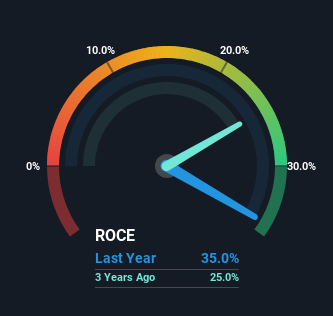Shareholders Would Enjoy A Repeat Of Akzo Nobel India's (NSE:AKZOINDIA) Recent Growth In Returns

Did you know there are some financial metrics that can provide clues of a potential multi-bagger? One common approach is to try and find a company with returns on capital employed (ROCE) that are increasing, in conjunction with a growing amount of capital employed. If you see this, it typically means it's a company with a great business model and plenty of profitable reinvestment opportunities. With that in mind, the ROCE of Akzo Nobel India (NSE:AKZOINDIA) looks great, so lets see what the trend can tell us.
Our free stock report includes 1 warning sign investors should be aware of before investing in Akzo Nobel India. Read for free now.Understanding Return On Capital Employed (ROCE)
If you haven't worked with ROCE before, it measures the 'return' (pre-tax profit) a company generates from capital employed in its business. To calculate this metric for Akzo Nobel India, this is the formula:
Return on Capital Employed = Earnings Before Interest and Tax (EBIT) ÷ (Total Assets - Current Liabilities)
0.35 = ₹5.6b ÷ (₹32b - ₹16b) (Based on the trailing twelve months to December 2024).
So, Akzo Nobel India has an ROCE of 35%. In absolute terms that's a great return and it's even better than the Chemicals industry average of 13%.
Check out our latest analysis for Akzo Nobel India

In the above chart we have measured Akzo Nobel India's prior ROCE against its prior performance, but the future is arguably more important. If you're interested, you can view the analysts predictions in our free analyst report for Akzo Nobel India .
How Are Returns Trending?
We like the trends that we're seeing from Akzo Nobel India. The numbers show that in the last five years, the returns generated on capital employed have grown considerably to 35%. The amount of capital employed has increased too, by 26%. This can indicate that there's plenty of opportunities to invest capital internally and at ever higher rates, a combination that's common among multi-baggers.
On a separate but related note, it's important to know that Akzo Nobel India has a current liabilities to total assets ratio of 50%, which we'd consider pretty high. This effectively means that suppliers (or short-term creditors) are funding a large portion of the business, so just be aware that this can introduce some elements of risk. While it's not necessarily a bad thing, it can be beneficial if this ratio is lower.
Our Take On Akzo Nobel India's ROCE
All in all, it's terrific to see that Akzo Nobel India is reaping the rewards from prior investments and is growing its capital base. And with the stock having performed exceptionally well over the last five years, these patterns are being accounted for by investors. In light of that, we think it's worth looking further into this stock because if Akzo Nobel India can keep these trends up, it could have a bright future ahead.
On a final note, we've found 1 warning sign for Akzo Nobel India that we think you should be aware of.
Akzo Nobel India is not the only stock earning high returns. If you'd like to see more, check out our free list of companies earning high returns on equity with solid fundamentals.
New: Manage All Your Stock Portfolios in One Place
We've created the ultimate portfolio companion for stock investors, and it's free.
• Connect an unlimited number of Portfolios and see your total in one currency
• Be alerted to new Warning Signs or Risks via email or mobile
• Track the Fair Value of your stocks
Have feedback on this article? Concerned about the content? Get in touch with us directly. Alternatively, email editorial-team (at) simplywallst.com.
This article by Simply Wall St is general in nature. We provide commentary based on historical data and analyst forecasts only using an unbiased methodology and our articles are not intended to be financial advice. It does not constitute a recommendation to buy or sell any stock, and does not take account of your objectives, or your financial situation. We aim to bring you long-term focused analysis driven by fundamental data. Note that our analysis may not factor in the latest price-sensitive company announcements or qualitative material. Simply Wall St has no position in any stocks mentioned.
About NSEI:AKZOINDIA
Akzo Nobel India
Manufactures, distributes, and sells paints and coatings in India and internationally.
Flawless balance sheet with proven track record.
Similar Companies
Market Insights
Community Narratives



